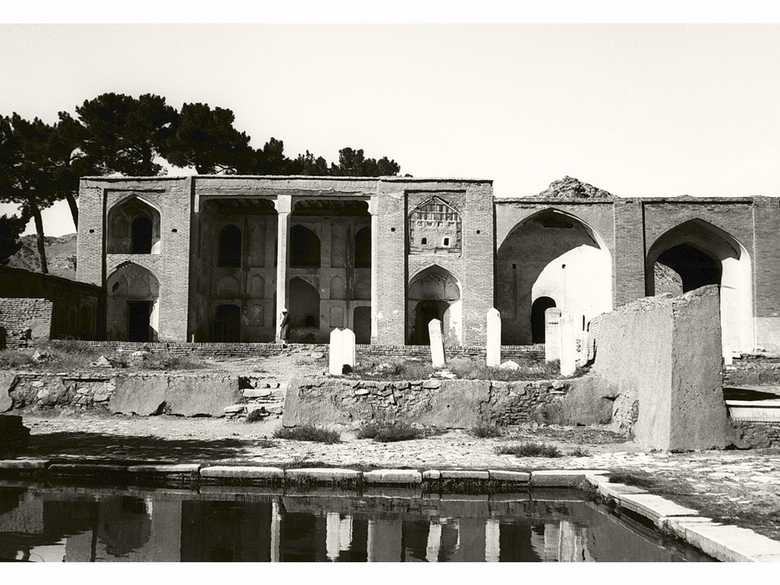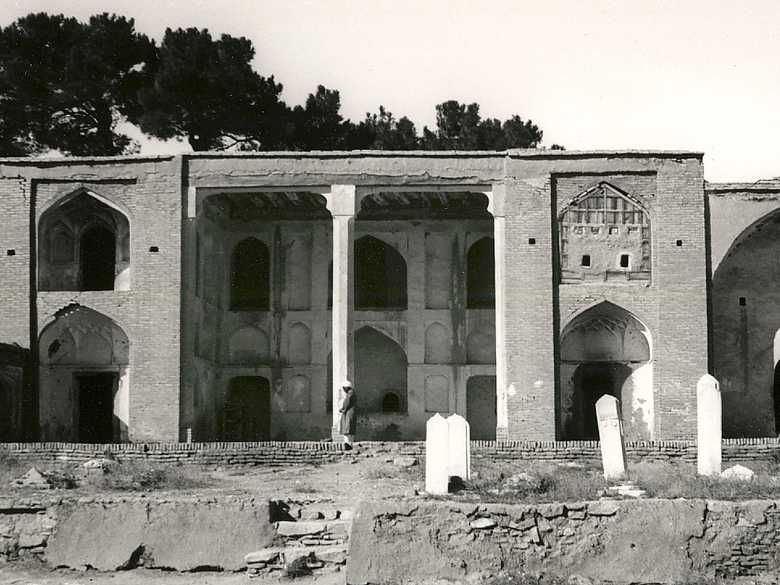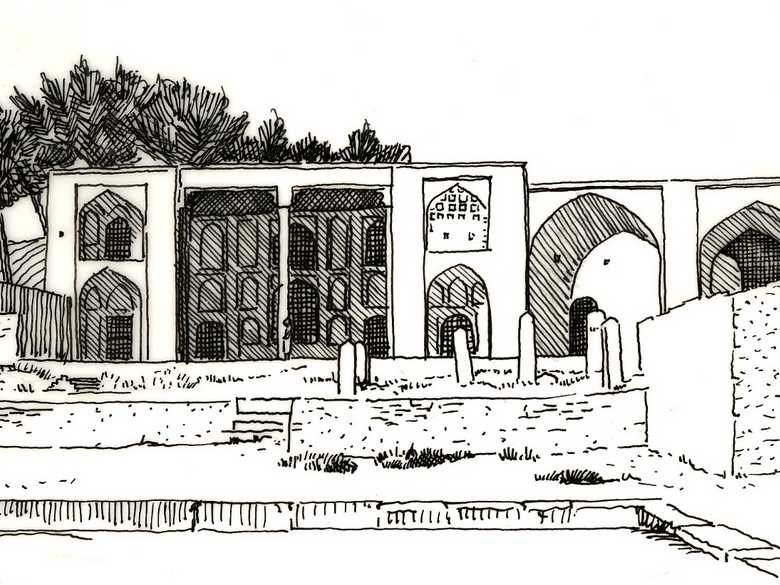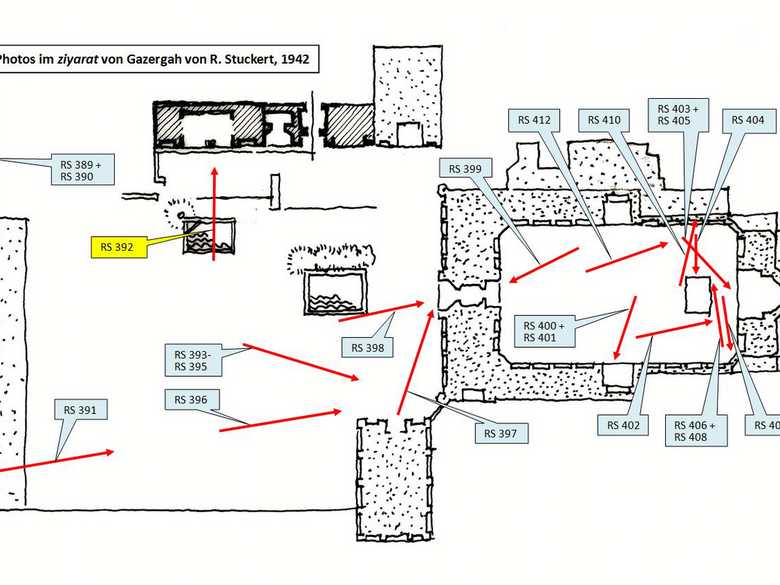RS 392 — Offene Gebetshalle neben hauz-e zamzam
|RS 392-1| Gebäude mit offener Gebetshalle an der Nordseite des Aussenhofes, neben dem Gebäude des hauz-e zamzam. Die Rückwand der Halle ist mit zahlreichen Nischen in der Art eines chini khana gegliedert. Im Vordergrund ein mit Steinplatten eingefasstes Wasser-Bassin.
|RS 392-3| Federzeichnung von R. Stuckert: die offene Gebetshalle im Vorhof von Gazergah, nach 1942 abgerissen.
|RS 392-1|
Gebäude mit offener Gebetshalle an der Nordseite des Aussenhofes, neben dem Gebäude des hauz-e zamzam. Die Rückwand der Halle ist mit zahlreichen Nischen in der Art eines chini khana gegliedert. Im Vordergrund ein mit Steinplatten eingefasstes Wasser-Bassin.
[Filmverzeichnis:] Vorhof, Seitenmoschee.
- R. Stuckert (1994): Erinnerungen an Afghanistan, S. 66: „Abb. 71: Offene Gebetshalle im Vorhof von Gazar-Gah, nach 1942 abgerissen.“
- C. E. Yate (1888): Northern Afghanistan or Letters from the Afghan Boundary Commission, S. 37: “At the entrance to the courtyard there is a large curious circular font or bowl made of white marble, and used, so far as I could make out, to mix sherbet in for the pilgrims visiting the shrine. Outside is the covered reservoir, locally said to have been built by a daughter of Shah Rukh; but the inscription, on being deciphered, showed that it was originally built by Shah Rukh himself, but fell into disrepair, and was restored in the year A.H. 1100 = A.D. 1689, by some lady of royal descent whose name is not given.”
- L. W. Adamec (1975): Herat and north-western Afghanistan, S. 133: Gazargah.
- N. H. Dupree (1977): An Historical Guide to Afghanistan, S. 256: “The Hauz-i-Zamzam is located to the north of the shrine. This reservoir is said to have been built by Shah Rukh in 1428, at which time he ordered that several goat skins of water drawn from the holy well of Zamzam in Mecca be mixed with the spring water to increase its sanctity. According to the long inscription over the stairs, the reservoir fell into disrepair and was repaired by a pious lady of Herat in 1688/9.”
- D. Brandenburg (1977): Herat, S. 42: „[…] Folgt man dem Pfad zur Linken, kommt man zu einem überdachten Reservoir: Hauz-i-Zamzam. Die lange Inschrift besagt, dass Shâh Rukh diesen Brunnen 1428 errichtet habe. Der Herrscher liess – so lautet die Überlieferung – eine Anzahl Ziegenhäute gefüllt mit dem heiligen Wasser des Brunnens Zamzam in Mekka dem Wasser dieser Zisterne zusetzen, um dem Khwâja Ansârî zu Ehren die Anziehungskraft des Heiligtums zu erhöhen. Eine fromme Dame und Nachfahrin Chingiz Khâns liess im 17. Jahrhundert den in Verfall geratenen Brunnen ausbessern; von ihr stammt die erwähnte Inschrift.“
- W. Ball (1981): Archaeological Gazetteer of Afghanistan, S. 103–104: Gazurgah.
- R. Samizay (1981): Islamic Architecture in Herat, S. 66: “Hawz-i-Zamzam: East of the garden, north of the shrine of Abdullah Ansari, there is a covered water reservoir known as Hawz-i-Zamzam. From an inscription in Nastaliq, on a tablet inside the building of a poem recording the construction date of the building as 1100 A.H. (1687 A.D.), it is evident that the structure was built by a queen from Genghis Khan's Dynasty who herself is buried in Gazargah. This reservoir used to have an underground passageway that lead to an underground mosque. The passageway is blocked, but the underground mosque still exists and is used for winter prayers.”
- T. Allen (1981): A Catalogue of the Toponyms and Monuments of Timurid Herat, S. 67 und S. 177.
- M. Fadaeian (2006): Herat Yesterday Today, S. 89–115: Khaje Abdullah Ansari.
Image No.
RS 392
Collection
Rudolf Stuckert 1940-1946
Series
RS 387-412, Herat, Gazergah
Format
Originalabzug 58/82 mm
Quality
sehr gut
Place, date
Herat, 1942
Descriptors
Latitude / Longitude34.374850 / 62.239900
Google Mapshttps://maps.google.com
Zoom Earthhttps://zoom.earth
You know more about this picture?





